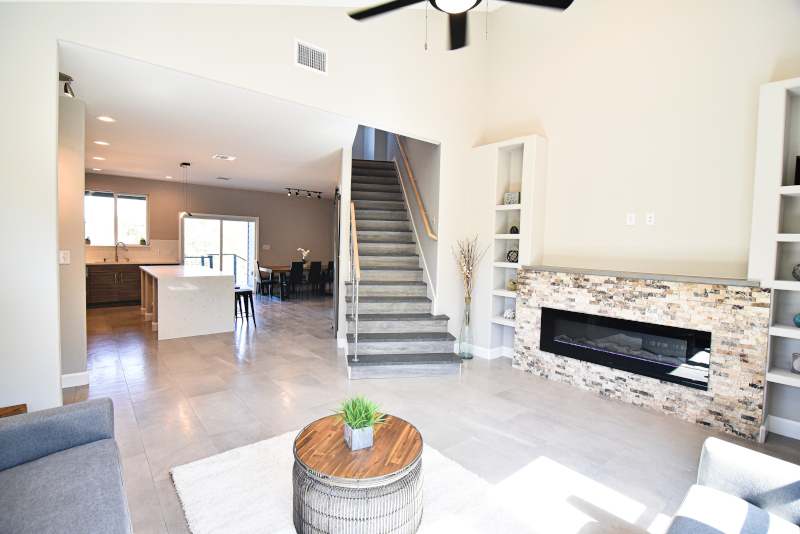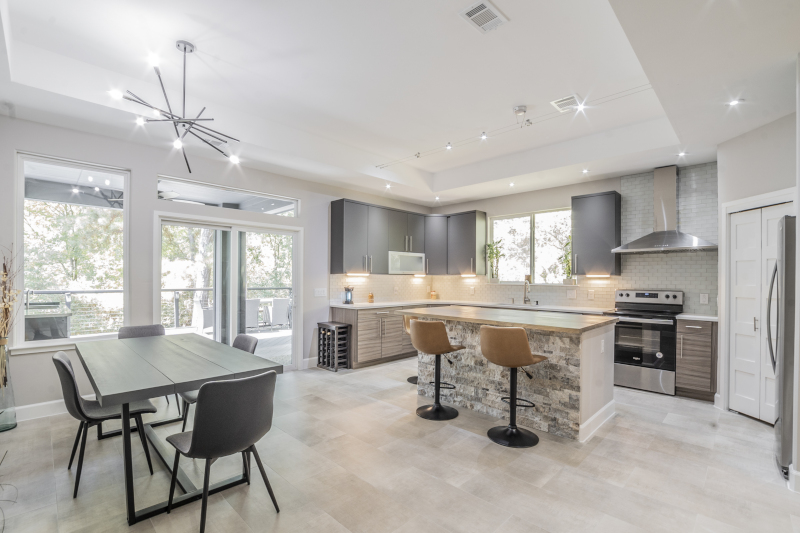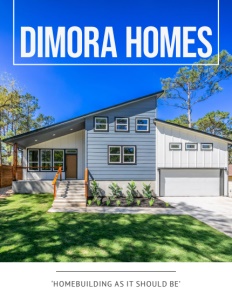Dimora Homes
‘Homebuilding as it Should Be’
Building high-efficiency homes with the client and sustainability in mind
For the owner of Dimora Homes, building bigger and better simply doesn’t cut it. Rather, building to the highest performance standards is the top goal for this dynamic and growing family builder specializing in sustainable, high-performance homes that meet a long list of client specifications.
“A high-performance home is durable, comfortable, healthy, and energy-efficient,” Scott True, owner of Dimora Homes, describes when asked what the defining criteria are behind their popular building methods.
“I have this trademarked slogan that says ‘homebuilding as it should be’ because we believe that all homes should be high performance. When you don’t build high performance you end up with problems in homes and create conditions that are conducive to mold, unhealthy air, and durability issues,” True continues.
The philosophy that True and his wife, both his partner in work and life, adhere to is simple; build in these high-efficiency options at the outset to avoid potential problems and higher costs down the road for homeowners.
“The absolute best thing you can do to be green is to optimize the enclosure as much as possible. That means making the house energy efficient by the way it is built.”

High-performance criteria based on client relationships
With green options, sustainability, and lessening our carbon footprint top of mind for many, homebuilders are slowly incorporating greener technologies into the overall building and design process; however only some builders are ‘truly’ taking the lead.
Dimora Homes, based in Austin, Texas is one such builder that has developed an edge in a burgeoning market. A family business by design, with a core philosophy that puts the client first, the company has achieved tangible success by never losing sight of why they are building.
“What I always say is that a lot of builders, especially the bigger ones, view the homebuilding process as nothing more than a financial transaction. That’s all it is.”
“We are not in that business. We have to make money, of course, but we’re not in the business of just transacting. We are in the business of building a home for somebody that is going to last through generations and be healthy and comfortable on delivery,” True elaborates.
“We generate business through referral. However, we get a lot of business off of YouTube,” True notes when asked how they have built up their loyal client base.
“I put some YouTube videos up about how we do things and why and this has gotten pretty popular. I have been featured on some really popular channels including Matt Reisinger who has a very popular building channel all about high performance and he has featured us on that and done quite a bit for us,” he adds.
Interest in Dimora Homes’s construction methods has not stopped at a social media presence, the builder has also earned the loyalty of valued vendors and subcontractors that the company can rely on to help move along their projects to construction completion.
“One name that comes to mind is Corbett Lunsford. He does our Manual J calculations and HVAC design. HVAC is such a big part of high performance. He helps us to get the correct sizing and design. This is what Corbett helps us do.”
“We also work with McCoy’s Building Supplies which pretty much caters to builders. They understand our needs and they know what we are ordering and why. They also understand why the delivery schedule is so important,” True outlines.
With increased interest in its construction approach, True has carefully outlined the criteria that form the foundation.
“There are four main things at the core of high-performance homes,” True says.
“Number one, above and beyond everything else is durability because it doesn’t matter if your home is efficient if it is going to eventually fall apart. So that is the most important thing,” he describes.
“Number two and three go hand in hand because you do the same tasks to achieve them: comfort and health.”
“Number two and three are achieved by building a tight envelope and controlling the air inside with precision.”
“Then the last thing, number four is energy efficiency and this is last for a reason because these other things are really what people care about and energy efficiency is the byproduct; it is going to come already if you are addressing all these other things in high performance.”
Ture highlights that high performance can always be ‘dialed in’ once the core foundation is addressed.
“Sometimes we want to be even more energy efficient and so we can dial in for things like increasing the levels of insulation, improving the windows, but doing this in a very precise manner because just adding stuff won’t cut it,” True explains.
When asked about the costs associated with these high-efficiency design measures, True is quick to answer.
“I think that high performance costs a lot of money when you don’t have any idea what you are doing because it is easy to solve a problem with money.”
“If you are educated about these things and understand the concepts and have some experience you can put together a system that achieves high performance at a pretty reasonable cost. Planning the house carefully and achieving high performance on a budget is possible,” he states.

‘Sustaining’ the design process
Beyond providing carefully planned out sustainable solutions for its clients, Dimora Homes facilitates a pleasant, communication-based, and transparent client experience, setting the bar high for its local competitors.
With a growing and engaged client base, True walks us through their client approach, further highlighting the central role given to the client; both in addressing what their needs are and collaborating to produce highly sustainable and comfortable homes for the long term
“The process looks different for everybody. Everyone has a different situation.”
“Sometimes people come to us and they already have plans that they like and they have it designed already and they come to us with very specific goals. With something like that, we sit down, look at the plans, and start developing an overall plan that is going to meet their goals,” he elaborates.
“Other times people come to us and they have no plans and they don’t know what their goals are. They just know that they want a well-built home.”
In this case, Dimora Homes will sit down one-on-one and talk about what is important to the client and help define goals through an open and transparent conversation to determine what might best suit the design of their home.
“The answer is not always the same,” True summarizes.
Dimora will provide a rough budget at the beginning of the client-conversation and as pre-planning advances, those budget goals may be adjusted to better cost out the project.
True highlights that the upfront process through to the last nail hammered into the house frame is tracked in Dimora Home’s CRM which allows for client communication and the ability to view the project during the construction phase.
Future Forward- A Passive Home Focus
While busy enough, Dimora Homes is always looking to the future and thinking about the best possible home designs that will uphold the highest standards of efficiency and sustainability.
When asked what direction the company is moving over the next few years, True answers easily.
“One design that I am very excited about is going to be a passive house.”
“A passive house” is a standard of building that represents a high-performance home that is as far as you can take it. Passive houses have historically been very difficult to build and there are only three or four of them in Austin,” he points out.
True emphasizes that there is a very strict building code associated with these specialized home designs which requires inspection and certification.
“This passive house that we are planning is what got me into this new area. Now that I am in it I have gone through the training and become a Phius Certified Builder (CPHB) and now we are in discussions with several other people about building more passive houses.
So beyond the passive house path, what next lies around the corner for Dimora Homes?
“I guess the other top priority is to always be learning because we never stop learning and continuing to grow,” he answers thoughtfully.
“We are setting a standard and setting an example for the industry to follow.”
AT A GLANCE
Dimora Homes
What: Leading High-Performance home builder directing its sustainable design efforts toward future passive home construction
Where: Austin, Texas



